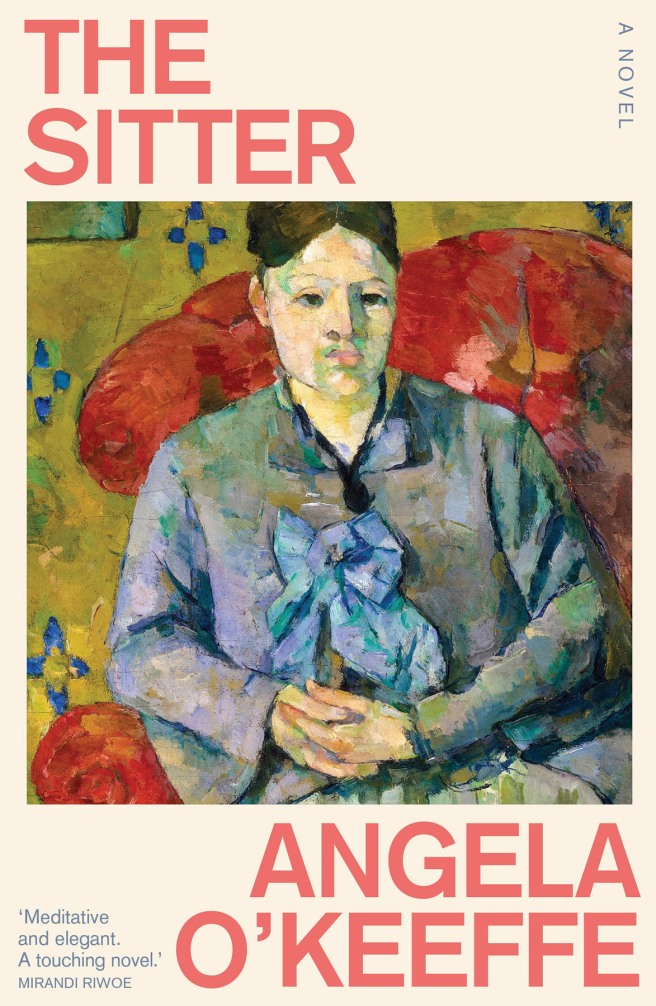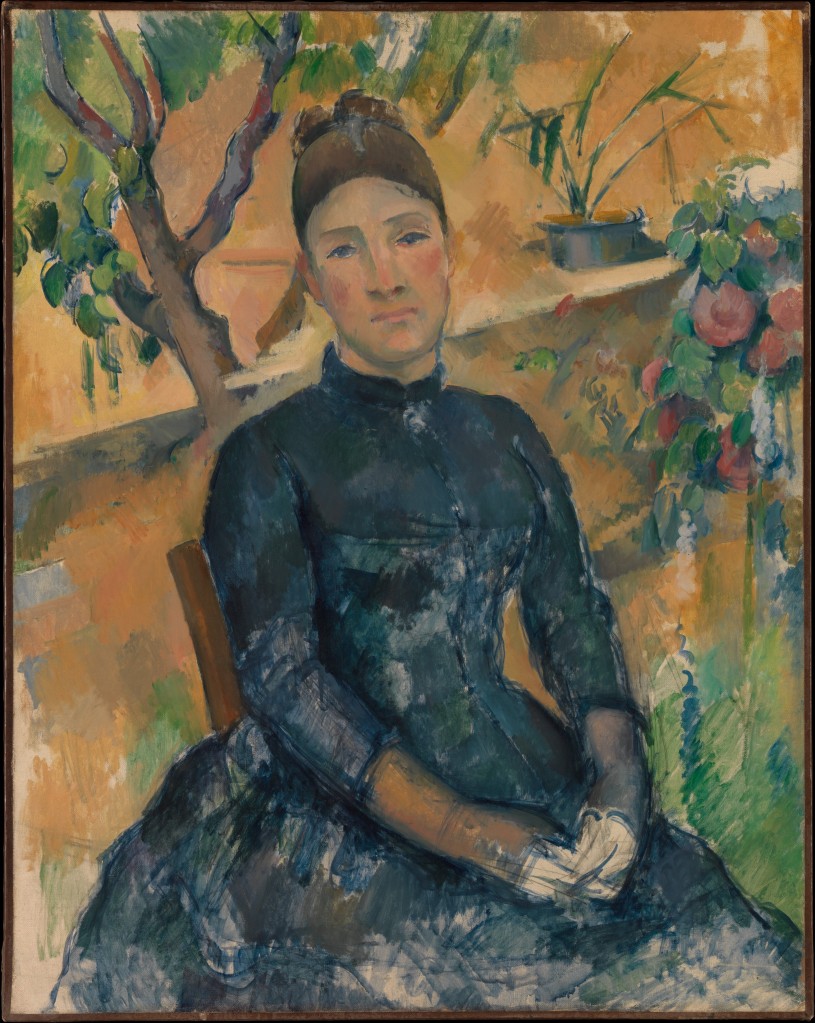
From the window of a hotel room in Paris: a view of rooftops, the brown river, a cobblestoned street, one corner of a scaffolded, burnt-out church. It is a morning in March 2020 and the air holds a breath of warmth. The sky is a pale, hopeful blue.
I love it when a book takes me down a rabbit hole or two!
The Sitter by Angela O’Keeffe had me scrambling down a few. The first, and most obvious one was Hortense Cézanne herself. After searching images to see how many of the 29 portraits of her I could find, and feeling dismayed by the sadness and detachment that oozes out of each and every one, I could see why O’Keeffe might have felt drawn to look more closely into Hortense’s interior life. There is a story crying out to be told – what was she thinking and feeling during those long hours she patiently sat still while Cézanne worked? What did she have to put on hold, to sit for him? What could she have been doing instead?
I was and am a practical person. A bookbinder must be, to make the stitches straight and firm, to make a space to hold a story, a space to hold a whole world; it is not done out of love but out of respect, which can be truer than love.
The Met held an exhibition titled, Madame Cézanne back in 2014-2015 which featured 25 of the 29 portraits that Cézanne painted of Hortense Fiquet- the overview is here. They hold one of my favourite portraits of her – Madame Cézanne in the Conservatory (1891) – that appears more wistful than the others. Perhaps it is how her rosy cheeks reflect the colour of the ripe fruit over her shoulder, the dappled morning light on her dress or the tuscan yellow wall behind her that her face is in danger of merging into. Maybe that’s the trick – the danger is there, but she doesn’t disappear into the background after all. She stares straight at us, almost in defiance, daring us to look and see her for who she really is.

Part way through her novel O’Keeffe mentions that the poet, Rainer Maria Rilke, wrote a letter to his wife, Clara, about the painting Madame Cézanne in a Red Armchair in October 1907. I was curious enough to hunt down the full excerpt.
Seated in this red armchair, a personality in itself, is a woman resting her hands in the lap of a dress with wide vertical stripes, most delicately rendered with discreet small patches of greenish yellow and yellowish green up to the edge of the blue-green jacket, which is held together in front by a blue silk tie shot with green reflections. In the brightness of her face, the proximity of all these colors is exploited for simple modeling; even the brown of her hair piled in curves above her temples and the flat brown in her eyes have to speak up against their surroundings. It is as though each spot had knowledge of every other. So much do they collaborate; so much is there of adaptation and denial; so much does each concern itself in its own way with balance, and create it, as the whole picture ultimately holds reality in balance. For if one says it is a red armchair (and it is the first and most definitive red armchair in all of the painting), it is only because it has within it a sum of color experience that, however, it happens, bolsters its redness and confirms it. To come to its most blatant expression, it is painted very heavily around the light face, so that a kind of waxy layer results. And yet the color does not overwhelm the object, which appears so perfectly translated into its painterly equivalent that its bourgeois reality, no matter how perfectly captured and factual, surrenders all heaviness for an ultimate existence in a picture. Everything, as I already wrote you, has become a matter of colors among themselves. One is considerate of the other, maintains itself against it, reflects on itself… You see how difficult it becomes when one wants to get quite close to the facts…
Now that’s how to write an artwork critique!
The next rabbit hole concerned the books mentioned by ‘the writer’ character. The first one is also the epigraph for The Sitter.
Shade, too, can be inhabited.
The Poetics of Space, Gaston Bachelard
First published in 1958 in France, The Poetics of Space discusses how architecture can be viewed through lived experience rather than origins – how built environments work within the context of nature provoking personal and emotional responses. He also declared that it is “better to live in a state of impermanence than in one of finality” where we can no longer dream about our future.
…what we do notice about an experience leaves a shadow in our mind, it seems to me – the shadow of what we might have noticed had we paid attention.
Olivia Laing’s books, Funny Weather: Art in an Emergency (2020) and Crudo (2017) are both referenced.
In an interview with Susan Wyndham earlier this year, O’Keeffe tells us how she had to get around a timing issue to have her character read Funny Weather within the timeframe of her novel – set in March 2020 – when the book wasn’t published until mid-April. During the early days of the pandemic, ‘the writer’ is wandering the streets of Paris and ends up in Shakespeare and Company, as you do. It turns out to be their last trading day before lockdown, and the bookseller is an Australian too. They talk about how much they adore Olivia Laing’s books. As she goes to leave, the bookseller gives her the advance copy of Funny Weather to take with her. Clever!
(FYI: I will be hunting down Laing’s first book, To the River: A Journey Beneath the Surface (2011) about walking the length of the river Ouse in Virginia Woolf’s footsteps).
Favourite Passages: I underlined quite a few sections; it was hard to keep this down to just two!
You probably wonder why I have kept silent all these years. Silence is seen as a weakness these days, a means of denying the true life of the self, one’s own history, and of course in some sense this is true. But it assumes that words are always up to the task, and I do not believe that they are….Words are wild animals; I keep a respectful distance. I do not hunt them; I let them come to me.
Her mother gives her a hard look that is also a wounded look. Her mother is skilful at looks.
Favourite Character:
There are really only two characters in The Sitter – Hortense and The Writer – and in many ways they are one and the same. I enjoyed being with both of them. We move from seeing Hortense through the writer’s gaze, to Hortense turning her gaze back onto the writer’s life.
The Writer’s Philosophy:
There are ways of being close to our most horrendous hurt and still being able to live.
Hortense’s Philosophy:
Each sitting, I withheld some aspect of myself. Perhaps he liked it that way; perhaps it was the very thing that kept him painting me, time after time….Each Hortense in the twenty-nine portraits is uniquely herself, different from all the others. And they are all different from me.
Favourite or Forget:
With all of its secrets, silences and hidden agendas, this slim book got under my skin. O’Keeffe reminds us that we can never assume that we know another person’s story and that even our own story is a constantly revised construct.
Read for #AusReadingMonth23
ISBN: 9780702266348 Imprint: University Queensland Press Published: 1 August 2023 Format: Paperback Pages: 180 Origin: ARC Dates Read: 19 October - 23 October 2023
| This post was written on the traditional land of the Wangal clan, one of the 29 clans of the Eora Nation within the Sydney basin. This Reading Life recognises the continuous custodianship & connection to Country of Aboriginal and Torres Strait Islander peoples for the lands, seas & skies on which we live. They are this nations first storytellers. |
I loved this too, and like all books exploring issues to do with art, I love fossicking around online to find the artworks as well!
LikeLike
After I spent time with Hortense’s 29 portraits, I had fun tracking down some of Cezanne’s Aix en Provence mountain paintings that Hortense was so disparaging about.
LikeLiked by 1 person
This sounds wonderful! Such a slim volume too, to send you off down all those avenues. Lovely review.
LikeLiked by 1 person
Thank you – I’m very keen to read her first novel now about Jackson Pollack’s painting Blue Poles.
LikeLiked by 1 person
This sounds so good Brona! I do love a book about the visual arts.
LikeLike
I think you would enjoy this too Cathy – & it’s novella length!
LikeLiked by 1 person
A winner then!
LikeLiked by 1 person
Thanks for tracking down that passage from Rilke and the Poetics of Space. I mark things I’d like to look up further from my reading but don’t always get down to doing it (sometimes the answer does come to me in my next few reads), but it’s wonderful how our reading gets us exploring and learning so much more.
LikeLiked by 1 person
I love it when a book opens my eyes to another author too, but is partly why my tbr is so out of control 😅
LikeLiked by 1 person
I review a small book about Cezanne (May 2022) and discoverd a wonderful artist. Of course his wife influenced him. 1870: he meets Hortense Fiquet. (was one of his models)
…not exactly a match made in heaven
…but they learn to live together/apart. Perhaps that can explain the portraits of his wife Hortense who always looked somber and constrained.
I have to go down my own rabbit hole…who is Angela O’ Keeffe?
LikeLike
I suspect the constrained look came about from Cezanne’s insistence on his sitters, sitting perfectly still and quiet while he painted! In the books Hortense also says “there is a thrill to unhappiness that most people do not understand.” I thought it was a great line, and said a lot about her.
LikeLiked by 1 person
What a great quote….definitely food for thought!
LikeLiked by 1 person
Gosh this sounds good, the letter from Rilke is amazingly descriptive. I’m enthralled by the time taken to write the letter and then the time Clara would have made to read the letter, there’s simply no rushing!
LikeLike
Yes, it’s hard to imagine that kind of considered communication between anyone, let alone a busy, working couple these days!
My favourite part is the ” bourgeois reality” – it’s not a phrase I would have thought to use, but it describes the scene exactly, suddenly turning this domestic portrait into a socio-political commentary.
LikeLiked by 1 person
Ooh, this sounds really good!
LikeLiked by 1 person
It really was 🙂
LikeLike
This sounds fascinating – Cezanne is one of my dad’s favourite artists, so I know his work quite well, but I never would have thought to read more about Hortense’s life. Great review as well – thank you for sharing all the additional bits your found going down those rabbit holes!
LikeLike
I love books that send me down rabbit holes, and I loved the time I spent looking at Cezanne’s paintings. It also makes me ridiculously happy to know that people travel from all over to visit Aix en Provence to take a photo of #Cezannesmountain to this day.
LikeLiked by 1 person
I enjoyed this one a lot!
LikeLiked by 1 person
Me too – now I want to read Night Blue.
LikeLiked by 1 person